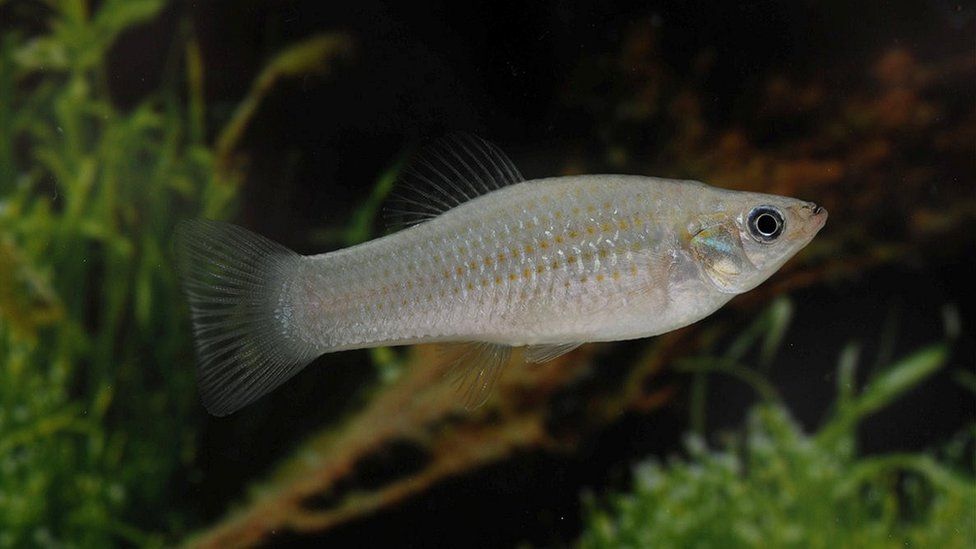Amazon fish challenges mutation idea
- Published

Evolutionary theory suggests that species favouring asexual reproduction will rapidly become extinct, as their genomes accumulate deadly mutations over time.
But a study on an Amazon fish has cast doubt on the rapidity of this decline.
Despite thousands of years of asexual reproduction, the genomes of the Amazon molly fish are remarkably stable and the species has survived.
Details of the work have been published in Nature Ecology and Evolution.
There are two fundamental ways in which new generations of life come to being - sexual and asexual reproduction.
Sexual reproduction relies on special reproductive male and female sex cells, the eggs and sperm, joining together during the process of fertilisation.
Each sex cell contains half the number of chromosomes of normal parent cells, then following fertilisation, when the egg and sperm fuse, the normal cell chromosome number is reinstated.
Asexual reproduction is different.
A life born of celibacy
Instead of creating a new generation by mixing equal measures of DNA from the mother and father, asexual reproduction dispenses with the male and instead creates new offspring containing an exact copy of the mother's genome - natural maternal cloning, if you like.
This is an incredibly efficient way of creating new life. By not wasting genetic material on the creation of males, all offspring arising from asexual reproduction can go on to produce more.
But there is a downside. Because the progeny are genetic facsimiles of the mother they exhibit limited variability.
And genetic variability can provide a big advantage. It's what allows populations to respond and overcome changes in environment and other selective pressures - it underpins survival of the fittest.
Sexual reproduction provides lots of scope to generate genetic variability; when pieces of individual chromosomes recombine as the eggs and sperm are formed and when the unique combinations of chromosomes are merged at fertilisation.
Another advantage of sexual reproduction is that harmful mutations, which accumulate naturally over time, are diluted out and their effects nullified during this genetic mixing.
Organisms relying on asexual transmission are presumed to forfeit these advantages.
Prof Manfred Schartl, who is based at the University of Würzburg and is one of the lead authors of the study, said: "The theoretical predictions were that an asexual species would undergo genomic decay and accumulate many bad mutations and, being clonal, would not be able to rely on high genetic diversity to react to new parasites or other changes in the environment.
"There were theoretical predictions that an asexual organism would demise after around 20,000 generations."
In evolutionary biology circles, this gradual and fatal accumulation of deadly mutations is known as Muller's ratchet, in honour of the Nobel prize-winning scientist Hermann Muller who came up with the theory.
But the latest study of the long-term stability of the Amazon molly fish genome has thrown up some surprising new insights into the potential cost of asexual reproduction.
Beating the odds
The Amazon molly fish is thought to be a hybrid that arose following breeding between two related species of fish - the Atlantic molly and the Sailfin molly.
In order to multiply, the resulting Amazon molly relies entirely on asexual reproduction; one of only a handful of backboned animals that reproduce this way.
In an unusual twist, the Amazon molly female can only reproduce when exposed to the sperm of a related species of molly, but the sperm DNA doesn't usually find its way into the offspring.
To define the impact of its celibate lifestyle, the team compared the genome sequences of Amazon molly fish collected from various locations in Mexico and Texas.
Using the genome sequences the research team were able to build a phylogenetic, or family, tree.
This tree showed that all the fish shared the same ancestor and this progenitor fish is predicted to have swum the American waters around 100,000 years ago.
Tenacious survivor
The Amazon molly had been around for half a million generations - far in excess of what theory would suggest.
Not only that, but when the scientists looked for hallmarks of long-term genomic decay there were very few, as Prof Schartl explained:
"What we found is that this fish had preserved its hybrid genome and what we know from plant or animal breeding is that when we try to make something better we breed a hybrid".
And he thinks it's this 'hybrid vigour' that underpins the Amazon molly's tenacious survival.
"What nature has done is create from the beginning a good hybrid, which then thrived."
"Of course it got mutations but what we feel has not been taken into consideration is that evolution will wipe out the deleterious mutations and only those that become better with good mutations will thrive."
Commenting on the significance of the work, Dr Laurence Loewe, assistant professor at the Wisconsin Institute for Discovery at the University of Wisconsin-Madison told the BBC:
"Usually species without regular recombination are not very long-lived evolutionarily. However, the Amazon molly seems to have found a way of surviving for a surprisingly long time without accumulating signatures of genomic decay".
"To figure out how, we will likely have to combine many of the exciting advances in evolutionary genetics from the last 100 years."